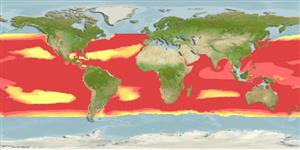Common names from other countries
>
Lophiiformes (Anglerfishes) >
Melanocetidae (Black Seadevils)
Etymology: Melanocetus: Greek, 'melas' or 'melanos' = black + Greek, 'ketos' = any large sea creature, more often referring to a whale (Ref. 86949); johnsonii: Named for Mr. Johnson of Madeira who found the first individual (Ref. 4525).
More on author: Günther.
Environment: milieu / climate zone / depth range / distribution range
Ecologie
marien bathypelagisch; diepte 100 - 4500 m (Ref. 74511), usually 100 - 1500 m (Ref. 4118). Deep-water; 50°N - 50°S, 180°W - 180°E
Tropical to temperate parts of all oceans. South China Sea and East China Sea (Ref.74511).
Grootte / Gewicht / Leeftijd
Maturity: Lm ? range ? - ? cm
Max length : 2.9 cm TL mannelijk / geslacht onbekend; (Ref. 4491); 18.0 cm TL (female)
Korte beschrijving
Determinatiesleutels | Morfologie | Morfometrie
Dorsale stekels (totaal) : 1; Dorsale zachte stralen (totaal) : 13 - 17; Anale stekels: 0; Anale zachte stralen: 3 - 5. Esca with compressed posterior and anterior crests; anterior margin of vomer nearly straight; minute skin spines present over most of body (Ref. 13608). Branchiostegal rays 6 (Ref. 36493). Caudal-fin rays 8. Scales are cone-shaped, hollow and translucent; with circular base and a free edge pointing towards the caudal region. Left otolith, oblong shape with regular edges, inner face does not present rostrum, antirostrum or cisure (Ref. 41244).
Distinguishing characteristics of metamorphosed female: least outside width between frontals 13.5-28.6% SL; upper jaw with 48-134 teeth, lower jaw 32-78 teeth; length of longest tooth in lower jaw 8.4-25% SL; width of pectoral fin lobe 10.7-17.8% SL; width of escal bulb 4.3-8.6% SL; length of illicium 32.4-60.8% SL; skin with minute spinules over most of body; relatively thick integument 1.55 mm (Ref. 86949). Distinguishing characteristics of metamorphosed male: upper denticular with 9-13 ventrally directed anterior teeth and posteromedial series of 8-11 teeth; lower denticular 12-24 teeth; posterior nostril contiguous with eye; at most 24 olfactory lamellae; skin naked or spinulose (Ref. 86949).
Meso- and bathypelagic (Ref. 58302). Males dwarfed and non-parasitic (Ref. 4491). Caught with plankton nets (Ref. 559). Capable of catching and swallowing prey larger than itself, as witness the approximately 24.0 cm SL specimen of Chauliodus sp. in the stomach of a 6.6 cm SL individual (NMNZ P 14537) (Ref. 58502). Larvae are found primarily in upper 100 m (Ref. 36493). Oviparous, with planktonic larvae (Ref. 36493). Eggs are presumably contained in floating gelatinous rafts (Ref. 36493).
Anderson, M.E. and R.W. Leslie, 2001. Review of the deep-sea anglerfishes (Lophiiformes: Ceratioidei) of southern Africa. Ichthyological Bulletin of the J.L.B. Smith Institute of Ichthyology 70:30 p. (Ref. 40877)
Status op de Rode Lijst van het IUCN (Ref. 130435)
CITES (Ref. 128078)
Not Evaluated
Gevaar voor de mens
Harmless
Gebruik door de mens
Visserij: van geen belang
Tools
Speciale rapporten
Download XML
Internetbronnen
Estimates based on models
Preferred temperature (Ref.
115969): 3.1 - 19.7, mean 7.4 (based on 4346 cells).
Fylogenetische diversiteitsindex (Ref.
82804): PD
50 = 0.5312 [Uniqueness, from 0.5 = low to 2.0 = high].
Bayesian length-weight: a=0.01995 (0.00906 - 0.04395), b=3.01 (2.83 - 3.19), in cm Total Length, based on all LWR estimates for this body shape (Ref.
93245).
Trofisch niveau (Ref.
69278): 4.1 ±0.69 se; based on food items.
Fishing Vulnerability (Ref.
59153): Low vulnerability (10 of 100).
